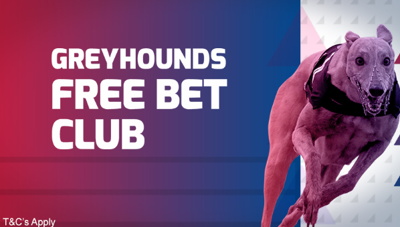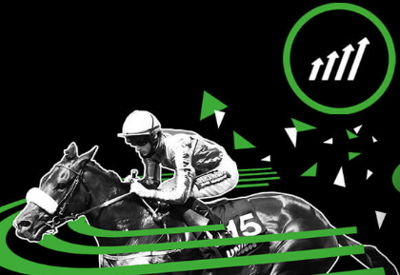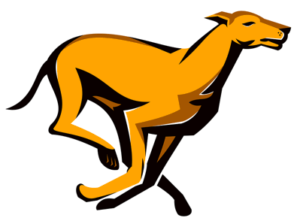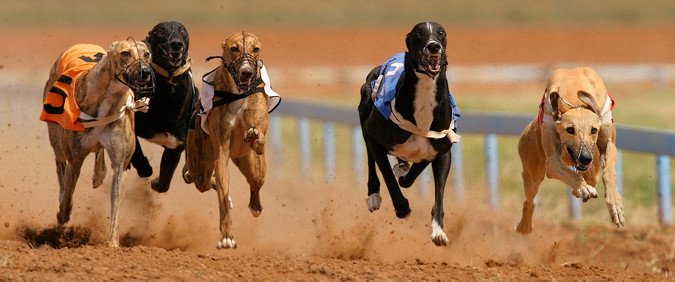Greyhound Racing Betting Sites & Offers
 On course greyhound betting was once one of Britain’s favourite working class pastimes. In 1946 after WWII nearly 35 million people paid to go attend dog tracks in the UK. Legalisation of off course gambling however along with a lack of TV coverage and sponsorship saw the sport nearly die out in the UK.
On course greyhound betting was once one of Britain’s favourite working class pastimes. In 1946 after WWII nearly 35 million people paid to go attend dog tracks in the UK. Legalisation of off course gambling however along with a lack of TV coverage and sponsorship saw the sport nearly die out in the UK.
Modern online betting sites actually became the saving grace of the sport in the UK. Streaming of races to audiences world-wide now means more people bet on UK greyhound races than ever before despite poor track attendances. The critical role of bookmakers in driving the sport has also resulted in plenty of greyhound deals and promotions including best odds guarantees, free bets and money back promotions.
Find out more about the best greyhound offers below and read further for more about the best sites to bet with for dog racing.
Dog Racing Best Odds Guaranteed
Greyhound Racing Free Bets, Money Back & Bonuses


Betfred always have greyhound offers. They are one of the oldest bookies and a long time supporter of greyhound racing. They champion the sport and care about it, which is why they are one of the very best for greyhound betting.
Currently you can get a 10% cash winnings boost on tricast bets placed on greyhound racing. All selections must run and must win
This is in addition to best price guarantee, streaming availability and lucky bonuses.


Unibet don't just offer an acca bonus for racing they allow eligible customers to claim a bonus up to three times each day. The bonus applies to accas with 3+ legs and is tiered from 10% (3-legs) to 40% (7+ legs). Maximum stake is £20 and it only applies to win bets or the win part of an each-way bet. BOG will not apply and you can't use it for future or special bets, only racing on the day.
The offer applies to both horse and greyhound racing and all winnings and extra winnings are cash with no maximum boost winnings limit. 18+, BeGambleAware.org.


If you are a fan of a Lucky bet then there is no better bookie to place one with than the home of the Lucky 15, Betfred. Fred Done, one of the original founders of Betfred came up with the bet type in the first place.
Place a Lucky 15 on any greyhound racing with Betfred and if all four selections win you will get a 10% bonus on your winnings (no limit) in cash. Get all five right in a Lucky 31 and get 20% extra and get all six correct in a Lucky 63, get a 25% win boost.
Should that not be enough of a reason to bet on Lucky’s with Betfred they will also give you an enhancement should you only get on correct. Pick only 1 out of 4 correct in a Lucky 15 and get 3x the odds on that one pick, get 1 out of 5 in a Lucky 31 get 4x the price and 1 out of 6 in a Lucky 63 will get you 5x the initial odds. The offer is also available from sister brand Totesport.


If you bet on any horse racing, greyhound racing and harness / trotting single markets with Unibet they will give you a an odds boost on stakes up to £20, on up to three bets each and every day. There is no minimum bet and all winnings and extra winnings are cash, the boost can be applied from the betslip.
Uniboosts are only available as single bets; multiples are ineligible, you are not able to be used in conjunction with freebet tokens / balances.
This is a great offer if you are likely to bet on horse and greyhound races anyway, especially for non-elite racing where it is rare to find offers. Uniboosts refresh at midnight each day.
Best Greyhound Racing Bookmakers
Coral
Coral’s free bets for winners and other offers makes it the place to bet for daily race fans. Coral in fact own Romford & Hove, shows you they take dog racing seriously.QuinnBet
A fantastic Irish bookmaker very serious about racing, good market, streaming and a suite of promotions that provide insurance and bonuses across the board.Greyhound Racing History, Rules & Major Meetings

When you think of the various sports that exist in the world, it’s easy to see how some of them got started. Throw a balloon at someone’s feet, for example, and see them immediately kick it up in the air as an indication of what they’d do if you threw them something more substantial. Line up in your car alongside someone at a red light and you’ll sometimes saw a look in their eye that suggests they’re going to try to take off quicker than you, immediately triggering your more competitive nature and making you realise why Formula 1 ever got started. If you’re unfortunate enough be a in a pub when two people start throwing punches, it’s equally as simple to see where the idea for professional boxing came from.
When sports involve animals, however, it’s a little bit more tricky to understand how someone figured out how to turn it from recreation into something fun. After all, humans understand competitiveness and sportsmanship in a way that dogs and horses never can. Yet make them into sports someone did, with horse racing and greyhound racing having a degree of similarity in the manner in which they’re run. Obviously one major thing missing from one to the other is the jockey, so how do dogs know how to run around a track? Why don’t they all just stop and sniff each other’s bums like you imagine they’d do in a park? Read on here to find out a little bit more about the world of greyhound racing, including where it all began.
History Of Greyhound Racing

Perhaps somewhat unsurprisingly, the history of greyhound racing is difficult to nail down if you want to be fairly exact about it. We do know that paintings of dogs that look suspiciously like greyhounds have been found on materials that date back more than four thousand years, with the Ancient Egyptians being being huge lovers of them. The Pharaohs adored them not only as pets but also as talented hunters. In Arabian culture, greyhounds were treated with such respect that their birth was celebrated almost as much as the birth of a son, allowing them to sleep in their tends and ride on their camels with them. The Persian, Greek and Roman civilisations also treated them royally, with people in England banned from owning them as pets because they were considered so noble.
You’ll have noted, of course, that there’s so far been no mention of them being raced against each other. That’s because the sport’s origin isn’t absolutely clear, though it’s likely to have started in the eleventh century in England. We do know that coursing rules were first introduced during the reign of Queen Elizabeth the First, with points awarded during a race for form, speed and agility. The main aim back then was for them to catch the hare, which eventually resulting in the invention of the mechanical hare in 1876. That allowed up to six dogs to be raced against each other on a straight track, yet it didn’t do enough to capture the imagination of the crowd, which was far more interested in placing bets on the winner.

It wasn’t until the development of a lure that could be sent around an oval track that greyhound racing as a sport truly began to take off. That happened in 1912 when a man named O.P. Smith came up with the idea. It began life in America, with the first track opening up in 1919. Things didn’t take off in the UK for another seven years, when a track called Belle Vue opened in Manchester in the North of the country. The fact that the track opened in a working class district helped the sport immeasurably, given that it appealed to working class people no end. The sport caught on rapidly, with more and more tracks opening up around the country in the years that followed.
By 1929, around fourteen million people attended greyhound races in the UK on a weekly basis. That crept even higher to about sixteen million at the sport’s peak, with those people spread over more than one hundred and forty tracks around the country. That has dropped down to less than twenty-seven in recent years, as the sport has become less popular for those looking for a night out. Of those twenty-seven stadiums, twenty-two are registered and five are what as known as ‘independent’ stadia. There are also countless unlicensed stadiums, known as ‘Flapper Courses’, but it’s impossible to know exactly how many because they’re not properly regulated.
Rules of Greyhound Racing

In terms of how greyhound racing works as a sport, it’s actually relatively simple. Long gone are the days of points being awarded according to a dog’s form or agility. Instead, it’s a simple matter of the greyhound that crosses the finish line before all of the others being declared the winner. The mechanical lure is sent whizzing around the track moments before the greyhounds are released from their trap, which is usually a container-type shape made up of metal bars. The greyhounds then race around the track in an attempt to catch the lure, which is often made to look like a hare in order to capture their attention.
Whereas in horse racing you’ll likely find that the number of horses taking part in an event differs from one race to the next, the same is not true of greyhound racing. Typically speaking, a greyhound track can handle a specific number of dogs, meaning that that number of greyhounds will be present for virtually all races. It’s often either five or six dogs that can race on a track, so that’s how many dogs you’ll see in each race unless there’s an injury to one of the competitors at the last moment. Even that’s not necessarily enough to stop the correct amount of greyhounds racing, however, with most tracks having reserve dogs that can be brought in if needs be.

Sometimes the racing can take place over hurdles, though the general manner in which it works remains the same. Given that there’s not much more to races than meets the eye, why is it a sport that is so appealing? There are numerous answers to that question, not least of which is that it’s a fun sport to bet on. The fact that the field is usually consistent makes it much easier for punters to feel as though they’re able to breakdown the competitors in a manner that allows them to get the feeling for which one is going to win. It also makes it simpler in terms of the types of bets that are on offer, with standardised wagers such as win, place and forecast bets tending to be the most common offered by the totalisator on track.
The other big reason that greyhound racing is so popular, and something that is as much a part of the sport as the lure whizzing around the track and the bookmakers on the side of it shouting out their odds, is the atmosphere you’ll encounter when you head to a stadium. It’s a thrilling sport, encouraging people to get involved at every turn. The result of that is that the sport is a family friendly one, being one that can be enjoyed by younger audiences as much as older ones. It’s also one that encourages big groups like stag dos and hen parties to rock up to, adding to that sense of a family atmosphere. All of that might not seem like it’s part of how the sport is played, but when something is such an important part of how the whole thing works it’s definitely worthy of a mention.
Major Greyhound Racing Meetings & Races

Just because greyhound racing is a relatively straightforward sport in terms of how it works, that doesn’t mean that it doesn’t lend itself to competition. There are numerous major events in the world of greyhound racing, often attached to specific stadia in the same way that horse races like the Grand National and Gold Cup will also be associated with Aintree and Cheltenham. Here’s a brief look at each of them:
- English Greyhound Derby – Probably the most distinguished race on the UK greyhound calendar. Dating back to 1927 and first held at White City stadium, it moved to Wimbledon in 1985 and then to Towcester in 2017 following the closure of Wimbledon. With prize money of nearly £400k with up to £200k for the winner it really is the top of the shop of Dog races. Run over 500 meters runners must qualify through 5 rounds of heats over one month.
- Golden Jacket – The Golden Jacket is a greyhound competition that started life back in 1975. It took place for the first time at Harringay Stadium, remaining there for nine years until the track closed and it needed to find a new home. At that point is was moved to Hall Green and Monmore for a year apiece, before finding its new home at Crayford in 1987, where it’s remained ever since.
- The Scottish Greyhound Derby – This is one of the Greyhound Classics, having been run for the first time as long ago as 1928. Back then the venue was Carntyne Stadium, remaining there for forty years until it was closed and the race had to be moved to the Shawfield Stadium. It was there for fifteen years, shifting to Powderhall Stadium in Edinburgh in 1987 for two years. It returned to Shawfield in 1989 and is still there now.
- William Hill Classic – The William Hill Classic only started in 1995, meaning it’s one of the youngest of the events on the list. It’s been held at Sunderland’s greyhound stadium for every running of the race and is part of the festival of racing that takes in the next event on our list, too. The reason it’s so important in the world of greyhound racing is that the prize for the winner is £25,000, which is substantial in the sport.
- William Hill Grand Prix – The William Hill Classic might be young, but the William Hill Grand Prix is even younger. It was only raced for the first time in 2007, making it the youngest of the important competition’s in the sport. As with the Classic, it’s always hosted at Sunderland and shouldn’t be confused with an old classic known as the Grand Prix, which used to be held at Walthamstow Stadium before it closed down.
- East Anglian Derby – The East Anglian Derby came under the rules of the National Greyhound Racing Club in 1975. It’s always been at Yarmouth Stadium, with a prize pot of around £15,000 awarded to the winner.
- The Grand National – It’s not just horse racing that boasts a Grand National, with greyhound racing’s event of the same name being a classic that was first established in 1927. It started life at White City Stadium, moving to Hall Green Stadium in 1985 and then shifting over to Wimbledon Stadium in 1999. It remained there for twelve years before the Greyhound Racing Association removed it from their portfolio and it ended up at Sittingbourne’s Central Park Stadium.
- St. Leger – Run at Wembley Stadium from its first year in 1928 for the seventy years that followed, the St. Leger is an original classic that moved to Wimbledon Stadium when Wembley Greyhounds ended in 1999. It is thought of as the sport’s premier stayers race and was moved from Wimbledon to the GRA’s sister track Perry Barr in 2017.
- Puppy Derby – The The Puppy Derby began life at Wimbledon Stadium in 1928, remaining there from the sport’s more formative years right through until the venue closed in 2017. At that point it moved to Towcester Greyhound Stadium, where the race had its prize money boosted to £20,000. That’s because other stadiums have started similar Puppy Derbies, though none have the prestige of this one.
- TV Trophy – The Television Trophy was inaugurated in 1952 and was initially shown live on the BBC. It remained on Sportsview, which later became Sportsnight, until the BBC cancelled the show in 1996. At that point it switched to Sky Sports, with the company broadcasting from the host venue, which changes on a fairly regular basis, ever since.
- The Oaks – The Oaks is the last of the Classics to take place in the year, occurring in December. It began life in 1927 at White City Stadium, becoming a Classic in 1939. It moved to Harringay Stadium in 1959 and then to Wimbledon Stadium from 1988 until 2012. The GRA moved it to Belle Vue Stadium 2013 and it’s been there since.
Greyhound Racing Key Facts & Figures
| Competition | Record Winning Greyhound | Record Winning Trainer |
|---|---|---|
| Golden Jacket | Bobs Regan / Wexford Minx | Derek Knight |
| The Scottish Greyhound Derby | Olives Best | Charlie Lister |
| William Hill Classic | N/A | Mark Wallis |
| William Hill Grand Prix | N/A | Jimmy Wright / Mark Wallis / Paul Young |
| East Anglian Derby | Our Rufus / Fear Zafonic | Charlie Lister |
| The Grand National | Sherrys Prince | Colin West |
| St. Leger | N/A | Mark Wallis |
| The Puppy Derby | N/A | Jack Harvey |
| TV Trophy | Scurlogue Champ / Ericas Equity / Midway Skipper | Paul Young |
| The Oaks | Queen of the Suir / Lizette / Ballinasloe Blondie / Cranog Bet | Stanley Biss |
Finally, here’s a look at the most successful horses, trainers and jockeys across those various events. For the purposes of ease, we’ve listed the most successful in the biggest races where necessary.









 ;
;

